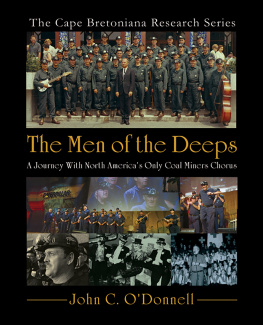THE MEN OF THE DEEPS
THE MEN OF THE DEEPS
A JOURNEY WITH NORTH AMERICA'S ONLY COAL MINERS CHORUS
JOHN C. O'DONNELL
THE CAPE BRETONIANA RESEARCH SERIES

CAPE BRETON UNIVERSITY PRESS
SYDNEY, NOVA SCOTIA
IN COOPERATION WITH
THE BEATON INSTITUTE, CAPE BRETON UNIVERSITY
Dedicated, in appreciation and with gratitude,
to The Men of the Deeps,
The sunlit voices
of the men who work deep in the dark.
Copyright 2016 John C. O'Donnell
All rights reserved. No part of this work may be reproduced or used in any form or by any means, electronic or mechanical, including photocopying, recording or any information storage or retrieval system, without the prior written permission of the publisher. Cape Breton University Press recognizes fair dealing uses under the Copyright Act (Canada). Responsibility for the research and permissions obtained for this publication rests with the author.
This book was made possible, in part, through the Robert J. Morgan Grant-in-Aid Program at the Beaton Institute at Cape Breton University. We are pleased to work with the Beaton Institute and other bodies to develop and promote our cultural resources.
Cover design: Cathy MacLean Design, Chticamp, NS.
Layout: Mike Hunter, West Bay and Sydney, NS.
eBook: tikaebooks.com
First printed in Canada.
Library and Archives Canada Cataloguing in Publication
O'Donnell, John C., 1935-, author
The Men of the Deeps : a journey with North America's
only coal miners chorus / John C. O'Donnell.
Includes bibliographical references.
Issued in print and electronic formats.
ISBN 978-1-77206-061-4 (paperback).--ISBN 978-1-77206-062-1
(pdf).--ISBN 978-1-77206-063-8 (epub).--ISBN 978-1-77206-064-5
(kindle)
1. Men of the Deeps--History. 2. Choirs (Music)--Nova
Scotia--Cape Breton Island--History. I. Title.
ML421.M534O36 2016 782.509716'95 C2016-905079-3
C2016-905080-7
Cape Breton University Press
PO Box 5300
Sydney, Nova Scotia B1P 6L2 Canada
www.cbupress.ca
Sold and distributed by
Nimbus Publishing
3731 MacKintosh St
Halifax, Nova Scotia B3K 5A5 Canada
www.nimbus.ca
Table of Contents
The Cape Breton coal miner has a heartbeat
it should not be allowed to die.
Nina Cohen
Acknowledgements
I am indebted to many friends, family and colleagues without whose support and encouragement this extraordinary journey may not have taken the course which brought me to this point. The inspiration to put it all down in writing was spearheaded by a grant from Cape Breton Universitys Beaton Institute and that financial incentive might never have happened had it not been for long-time friend and colleague, now deceased, Robert (Bob) Morgan.
Throughout his career Bob was passionately interested in, and a supporter of, anything Cape Breton. Because of this passion, he was kind enough to leave a legacy to his beloved Beaton Institute. The Robert J. Morgan Grant-in-Aid Program is intended to assist researchers of Cape Breton-related themes to reach a broader audience through publication by CBU Press and by inclusion in a special Beaton Institute publication series known as Cape Bretoniana.
I wish to acknowledge at the outset Cape Breton University, the Beaton Institute and the late Bob Morgan for the support and encouragement they have given me throughout my journey with North Americas only coal miners chorus.
My granddaughter, Clara Maltby, was chiefly responsible for helping me to organize and make sense of the reams of notes, letters, news articles and countless memorabilia scattered through my files. Her organizational skills were invaluable at the outset of this project.
And I am indebted to the readers of my rough text as it progressed over the past several months:
Lionel Doucette and Silver Donald Cameron were particularly helpful. Allister and Fiona MacGillivray, Scott Macmillan and Jennifer Brickenden, Gordon Sheriff, Yogi Muise, Jim MacLellan, Bob Roper, Stephen Muise and Jenn Sheppard, and my good friend, Bob Missen, all passed along helpful hints to aid the flow of the text outlining the progression of this fifty-year journey. Fr. Greg MacLeod and Fr. Dan Doucet, two very special Cape Breton friends, provided me with hospitality most particularly following those weekly Tuesday night summer concerts at the Cape Breton Miners Museum. Their generosity and admiration for The Men of the Deeps deserves very special recognition.
I also wish to recognize Dr. Richard MacKinnon, Professor of Folklore at Cape Breton University and chair of that department, for his generosity in providing the foreword to this publication. Dr. MacKinnon is also founding director of the Centre for Cape Breton Studies at CBU.
Cape Breton Universitys Beaton Institute is a jewel and a valuable source for researchers of the islands diverse cultural mosaic. Thank goodness for the encouragement and assistance of Catherine Arseneau, director of the Beaton Institute and also archivist, Jane Arnold, along with Mike Hunter and everyone at CBU Press. This project would not have come to fruition without their valuable advice and input.
Throughout my fifty-year association with The Men of the Deeps my family has been a constant support and encouragement. It is well-known that my commitment to the choir involved almost weekly trips between Antigonish and Glace Bay a round-trip distance of close to 500 kilometers. That kind of intense commitment would not have been possible without the faithful support and encouragement of my wife and children. I am grateful.
J.C.O'D.
A note from the editors
Responsibility for the writing, research and permissions obtained for this publication rests with the author. Effort has been made to properly credit the sources of images. In a book like this, there may be errors or oversights. CBU Press and our authors do recognize our mutual obligation with respect to rights and permissions and apologize for shortcomings.
Here and there, image quality may be lacking, but such is the nature of historical research and personal memoir. Clippings, copies, old photos and less-than-desirable lighting are all factors in collecting; we have done our best to put such images in the best light possible.
All clippings and photos have been provided by the author except where noted.
Foreword
Coal mining has been an essential part of Cape Breton Islands landscape and culture since at least the early 18th century. As with the British Isles and other regions around the world, Cape Breton was heavily influenced by the Industrial Revolution, which began in the 18th century and continued throughout the 19th and early 20th centuries.
As the 19th century unfolded, mines expanded throughout Nova Scotia as mining methods became more sophisticated and demand for coal to fuel growing industries, including steamships, steadily increased. Increasingly larger workforces also became more organized. As historian Ian McKay has noted, strikes, labour unrest and struggles for better pay and working conditions became common.
Lowland Scots and English settlers from the coal fields of the British Isles came to develop Cape Breton mines between 1827 and 1857 when a British-based company, the General Mining Association (GMA), held a monopoly on Cape Breton coal. As historian Del Muise notes, possessing control of all the coal reserves in the province and fairly strong financial backing in England, the company proceeded to revolutionize the industry in Nova Scotia.










